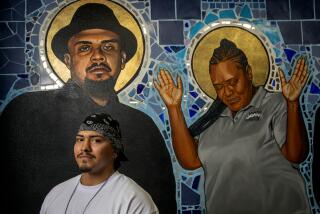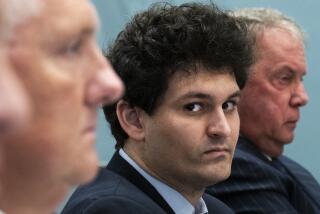Norton J. Kiritz, 70; He Refined the Art of Charity Grant-Writing
- Share via
Norton J. Kiritz, who transformed the nonprofit sector by streamlining and demystifying the process of obtaining grant money, died of cancer Jan. 30 at Good Samaritan Hospital in Los Angeles. He was 70.
Kiritz was founder and president of the Grantsmanship Center. Since 1972, the L.A.-based center has trained 100,000 people from nonprofit organizations and public agencies around the country in the art of writing grant proposals.
Knowing who the benefactors are and how to effectively appeal for their money is not an esoteric pursuit: There are more than 1.2 million nonprofit organizations in the U.S. and 99,000 grant-making foundations, which dispense billions of dollars each year.
Kiritz, who had spent years as a foot soldier in President Johnson’s war on poverty, had seen many nonprofit groups with worthy causes struggle to keep their programs alive because they didn’t know the makeup of a good grant proposal. He developed a five-day workshop on the basics and wrote a short how-to manual that quickly became the bible of grant writers in the nonprofit world.
But he was not merely teaching them to fill in the blanks; he required them to examine and concisely articulate their organization’s objectives and methodology, bringing a level of discipline and sophistication to what had been an ill-defined endeavor.
“He changed so much about the way grant proposals are written,” said Jack Shakely, the former president of the California Community Foundation, who was one of Kiritz’s first workshop leaders. “In the old days it was ‘Send us money because we’re good people.’ He realized a really good proposal is a program plan. He was the first to [develop] a scientific method for nonprofit organizations seeking grants.”
His curriculum was easy to teach and to learn, which “unleashed hundreds of people onto thousands of foundations,” said Joan Flanagan, an author and expert on grass-roots fundraising. “That broke up the elite club. Before Norton came along, getting grants was all about relationships -- who knew who from the club or Yale or wherever.... Now anybody could learn how to do it.”One beneficiary of Kiritz’s training was Sister June Wilkerson, a Dominican nun who wanted to open a tattoo-removal clinic for gang members in the San Fernando Valley.
“As a beginner you think, ‘Oh, my goodness, I can’t write a grant.’ Norton said this is no big deal,” Wilkerson said.
She subsequently wrote proposals that brought in $40,000 in grant money for her program, which received national attention as one of the first of its kind.
By 1977, five years after the Grantsmanship Center opened, an outside evaluation showed that Kiritz’s approach was highly successful: 62% of 1,400 proposals submitted by workshop graduates were granted, with awards exceeding $130 million. He became known as the guru of the grants game.
He also was an influential advocate of philanthropic reform, whose testimony in 1975 before the blue-ribbon Commission on Private Philanthropy and Public Needs sparked dialogue on the need for greater openness on the part of grant-makers about how they operate.
The son of a shoe salesman, Kiritz was born in New York City. At his parents’ urging, he enrolled in Cornell University’s engineering school, but he was more people-oriented and in the 1950s came west to attend UCLA, where he studied psychology.
He held a number of jobs after college, including postal worker and probation officer. He briefly ran a dog-finding business after seeing how much work was involved in retrieving his own lost dog. Later, when he couldn’t find a suitable summer camp for his son, he opened his own in Topanga Canyon and called it Summerhill Ranch in tribute to the progressive philosophy espoused by A.S. Neill, founder of the legendary British alternative school Summerhill.
Neither the pet-finding business nor the camp lasted, but the enterprising spirit that produced them eventually set Kiritz’s future course. He became a social entrepreneur decades before the term became fashionable, a pragmatic visionary whose inventiveness was directed at changing society, or at least an important segment of it.
“He was a man who could see that the whole social service world needed to be more professionally managed,” Shakely said.
Kiritz began to grasp the problem when he was planning director for the anti-poverty Los Angeles Community Action Agency during the 1960s, when Johnson’s “Great Society” reforms channeled government resources into improving opportunities for racial minorities and the poor. Kiritz’s job involved writing grant proposals and working with small community nonprofit groups enlisted in the war on poverty. Many of the groups struggled to keep their programs afloat, and he soon understood what underlay their difficulties.
He found that many of them were intimidated by the grant process and had fuzzy goals that changed depending on whose money they were applying for.
“He really wanted these little groups to survive,” said Marc Green, vice president of the Grantsmanship Center, “but he recognized that they weren’t focused. They really did not appreciate the necessity of presenting a plan ... to persuade the funder that they could deliver.”
Kiritz, a big (6 feet 2) burly man with a gravelly voice whose favorite attire included Hawaiian shirts, worked on his training program for a year without pay before launching the Grantsmanship Center as an independent, nonprofit corporation. It would be self-supporting, funded not with grants but by tuition and the sale of low-cost training materials and other publications.
The workshops were an instant success. “You could come in green as a gourd and go home five days later with a completed proposal,” said Flanagan, who took Kiritz’s workshop in 1975 and later became a trainer and a contributor to the center’s magazine, the Grantsmanship Center News.
Central to the workshop’s success was Kiritz’s manual, “Program Planning and Proposal Writing.” Despite the plain-wrap title, it became a bestseller in the nonprofit training world, with more than 1 million copies in print.
The heart of the document addresses the need to clearly state the reason for the grant proposal -- what Kiritz called “the problem statement.” It also outlines other requirements, including defining the goals of the proposed program and methods for attaining them, a plan for evaluating results, and projecting a budget.
Along the way it offers much practical advice, such as avoiding extravagant bindings or covers for the proposal, which Kiritz said could suggest a tendency to waste money.
He often used humor to make a point. On the question of how long a proposal should be, for instance, he wrote: “Just long enough for you to clearly communicate your message, but not long enough to produce a stupor.” He implored grant writers to write in plain English and not “demonstrate your mastery of bureaucratese.”
He also urged them to maintain a positive tone. “Writing for grant support is not like writing home from college for money,” he wrote. “You don’t have to apologize. You’re an applicant, not a supplicant! Don’t beg!”
These principles formed the bedrock of grantsmanship, which Kiritz simply defined as “never having to say you’re broke.”
He is survived by his wife, Cathleen, of Redondo Beach; two sons, Nicholas and Alexander; and a brother, Stewart, of Palo Alto. A memorial celebration will be held at 2 p.m. Saturday at the Wilshire Grand Hotel in Los Angeles.
More to Read
Sign up for Essential California
The most important California stories and recommendations in your inbox every morning.
You may occasionally receive promotional content from the Los Angeles Times.










